blackout美国64年大停电讲义教材
Emergency Blackout紧急停电处理程序

紧急停电处理程序Procedures to Deal with Emergency BlackoutA.如果已经接到停电通知,那么,If having received blackout notice from property management, then:1.管理层应将停电的有关情況告诉所有员工。
Management should inform all associates of blackout.2.配备有电脑的员工,在通知的停电时间前退出所有正在使用中地应用系统,并关闭电脑电源。
待电力恢复后重新开启电源。
Associates needing to work with computers should log out of the system and turn off the computers before the time of blackout.3.商场在通知时间前打电话到美国FIELD SUPPORT,通知其关闭相应商场的系统。
并在电力恢复后在通知美国重新开启系统。
Field Support in America should be informed before the time of blackout to close system of related stores and re-open it after power is restored.4.各部门作好应付停电的准备工作,所有的手电筒备好电池。
Each dept. prepares well for power cut, adequate batteries should be in place for all flashlights.5.工程/维修部认真检查发电机/后备电源/应急照明灯/疏散指示灯等设备,确保正常工作。
(工程/维修部应定期维修保养发电机,并保证有充足的柴油。
Construction/Maintenance dept. checks carefully generator/reserve power/emergency light/exit light, etc. to make sure all the equipment can work properly.( Construction/Maintenance dept. should make it a rule to serve generator regularly and fill it with gas.)6.防损部各岗位做好应急准备工作。
课件4:第4课 经济大危机

这暴露了资本家什么本性?
受害最深的是广大劳动人民,失 业工人超过3000万,他们饥寒交迫、 流离失所。但有一个奇怪的现象, 不知大家能否解释,在劳动人民吃 不饱、穿不暖时,资本家却把牛奶 成吨成吨地倒入臭水沟,把麦穗当 煤烧,把大批牲畜屠宰埋掉……
暴露了资本主义制度的腐朽和罪恶, 资本家的目的是保住商品的价格和市 场,保住利润。
一名工人的家庭生活一角
这位32岁的母亲卖掉了房 子和服饰,以便全家七个 孩子能有吃的。全家只能 吃捡来的蔬菜度日。
金融危机时低价出售汽车
我会三项技能,我 会说三国语言,我已经 有三年工龄了,我有三 个孩子,我已经失业三 个月了,我现在仅仅需 要一份工作。
经济危机袭击下的德国失业工人
在排队领取土豆等救济食品的人们
美国的繁荣
1929年,美国的汽车产量为将近540万辆,平均每6人一辆汽车。 美国工业在资本主义世界工业总产值中的比重在1913年为38%,
1929年为48.5%。 1929年,美国的黄金储备占世界黄金储备的一半以上。
材料一:20年代美国国民收入的三分之一为占人口5%的最富有 者攫取……21%的家庭年收入不到1 000美元,占国民收入的4%。
影响到整个资本主义世界,造成工业、农业、商业 与金融部门的危机
从1929年到1933年,持续五年
(3)危机的影响 A.经济上:引起资本主义国家经济大萧条。 B.政治上:引发各国政治与社会危机 C.国际关系上:加剧各国的矛盾与冲突,引出一连串关税战、倾销战
与货币战。
与此同时,在密西西比河畔,农场主们正在将一桶桶的牛奶倒入河 水,把一车车的大肥猪倒进河中。
1.规定各企业的生产规模、价格水平、 市场分配、工资水平和工作日时数。
GSV反恐培训教材
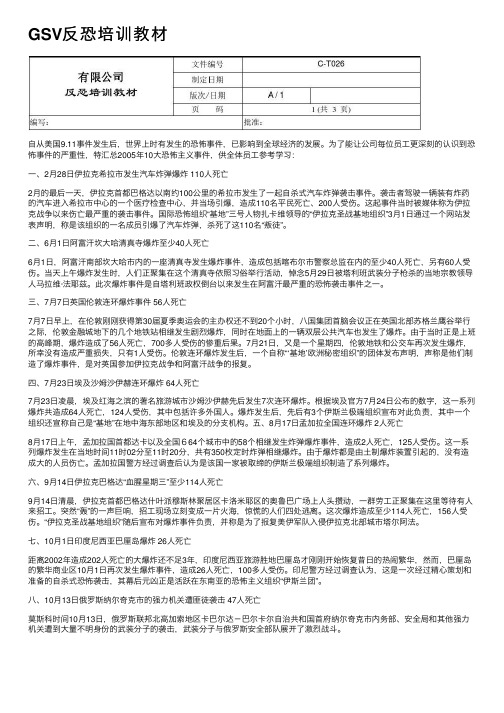
GSV反恐培训教材⾃从美国9.11事件发⽣后,世界上时有发⽣的恐怖事件,已影响到全球经济的发展。
为了能让公司每位员⼯更深刻的认识到恐怖事件的严重性,特汇总2005年10⼤恐怖主义事件,供全体员⼯参考学习:⼀、2⽉28⽇伊拉克希拉市发⽣汽车炸弹爆炸 110⼈死亡2⽉的最后⼀天,伊拉克⾸都巴格达以南约100公⾥的希拉市发⽣了⼀起⾃杀式汽车炸弹袭击事件。
袭击者驾驶⼀辆装有炸药的汽车进⼊希拉市中⼼的⼀个医疗检查中⼼,并当场引爆,造成110名平民死亡、200⼈受伤。
这起事件当时被媒体称为伊拉克战争以来伤亡最严重的袭击事件。
国际恐怖组织“基地”三号⼈物扎卡维领导的“伊拉克圣战基地组织”3⽉1⽇通过⼀个⽹站发表声明,称是该组织的⼀名成员引爆了汽车炸弹,杀死了这110名“叛徒”。
⼆、6⽉1⽇阿富汗坎⼤哈清真寺爆炸⾄少40⼈死亡6⽉1⽇,阿富汗南部坎⼤哈市内的⼀座清真寺发⽣爆炸事件,造成包括喀布尔市警察总监在内的⾄少40⼈死亡,另有60⼈受伤。
当天上午爆炸发⽣时,⼈们正聚集在这个清真寺依照习俗举⾏活动,悼念5⽉29⽇被塔利班武装分⼦枪杀的当地宗教领导⼈马拉维·法耶兹。
此次爆炸事件是⾃塔利班政权倒台以来发⽣在阿富汗最严重的恐怖袭击事件之⼀。
三、7⽉7⽇英国伦敦连环爆炸事件 56⼈死亡7⽉7⽇早上,在伦敦刚刚获得第30届夏季奥运会的主办权还不到20个⼩时,⼋国集团⾸脑会议正在英国北部苏格兰鹰⾕举⾏之际,伦敦⾦融城地下的⼏个地铁站相继发⽣剧烈爆炸,同时在地⾯上的⼀辆双层公共汽车也发⽣了爆炸。
由于当时正是上班的⾼峰期,爆炸造成了56⼈死亡,700多⼈受伤的惨重后果。
7⽉21⽇,⼜是⼀个星期四,伦敦地铁和公交车再次发⽣爆炸,所幸没有造成严重损失,只有1⼈受伤。
伦敦连环爆炸发⽣后,⼀个⾃称“‘基地’欧洲秘密组织”的团体发布声明,声称是他们制造了爆炸事件,是对英国参加伊拉克战争和阿富汗战争的报复。
四、7⽉23⽇埃及沙姆沙伊赫连环爆炸 64⼈死亡7⽉23⽇凌晨,埃及红海之滨的著名旅游城市沙姆沙伊赫先后发⽣7次连环爆炸。
美加_8_14_大停电事故初步分析以及应吸取的教训_印永华
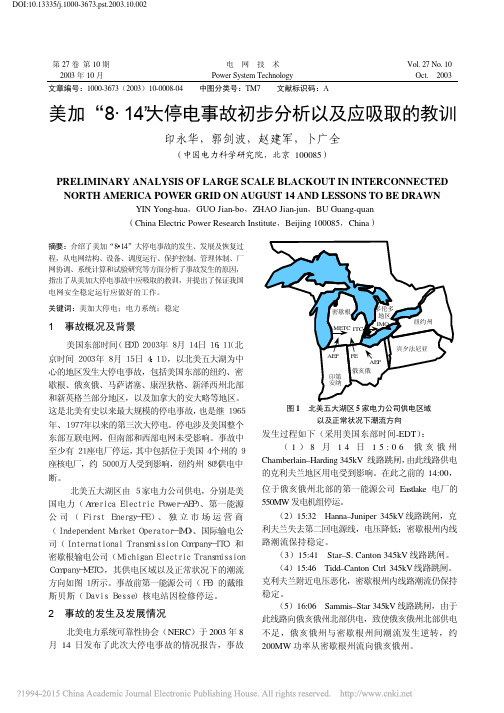
10
Power System Technology
Vol. 27 No. 10
及时有效的信息交换,因此在事故发展过程中,无法 做到对事故处理的统一指挥,导致了事故蔓延扩大。 国际电网公司(ITC)追踪到大停电以前 1h 5min 的数 据,认为如果能够早一点得到系统发生事故的一些异 常信号,就可能及时采取应急措施,制止大停电事故 的发生。
美加“8·14”大停电事故初步分析以及应吸取的教训
印永华,郭剑波,赵建军,卜广全
(中国电力科学研究院,北京 100085)
PRELIMINARY ANALYSIS OF LARGE SCALE BLACKOUT IN INTERCONNECTED NORTH AMERICA POWER GRID ON AUGUST 14 AND LESSONS TO BE DRAWN
经济大危机PPT课件30 人教版优秀课件

建筑业
流浪的母亲
第4课
经济大危机
The Great Depression
1922年到1929年,经济迎来了飞速增长,平均年 GNP(国民生产总值)增长率高达5.5%。
失业率从战前的11%下降至20年代后期的3.5%。 到1929年,在美国占人口5%的富人的收入几乎占全 部国民收入的1/3,而全年收入大约在2000美元左右的 贫困户占家庭总数的60%,还有21%的家庭年收入不到 1000美元。
罗斯福新政的措施: 1.整顿金融 2.恢复工业 3.调整农业 4.举办公共工程
罗斯福新政
1.时间: 1933年 2.目的:在资本主义制度内部进行调整,加强国家对经
济的干预和指导,以消除经济危机。 3.特点:
4.中心措施:对工业的调整,颁布《国家工业复兴法》。 5.成效:
蓝鹰标志 凡是接受法规的企业,一律发给印有“我们 尽我们的职责”的蓝鹰标志。
当时美国社会财富的分布状况如何?
各抒己见 1.当时美国社会财富的分布状况如何? 2.为谋暴利,资本家又是如何刺激消费的? 3.股票市场为何没有发现问题?
各抒己见
1.当时美国社会财富的分布状况如何? 贫富分化严重,限制社会实际消费能力
2.为谋暴利,资本家又是如何刺激消费的? 盲目扩大生产,分期付款和银行信贷,造成虚 假消费 3.股票市场为何没有发现问题?
最早出现的国家 美国
特点
时间比较长、范围特别广、破坏性特 别大
影响
美国儿歌
梅隆拉响汽笛, 胡佛敲起钟, 华尔街发出信号, 美国往地狱冲。
千百万人只因像畜生那样生活,才免于死亡。 宾夕法尼亚州的乡下人吃野草根、蒲公英;肯塔 基州的人吃紫萝兰叶、野葱、勿忘我草、野莴苣 以及一向专给牲口吃的野草。城里的孩子妈妈在 码头上徘徊等待,一有腐烂的水果蔬菜扔出来, 就上去同野狗争夺。蔬菜从码头装上卡车,她们 就跟在后边跑,有什么掉下来就捡。中西部地区 一所旅馆的厨师把一桶残菜剩羹放在厨房外的小 巷里,立即有十来个人从黑暗中冲出来抢。
recent initiaatives by the basel-based r_qt0806
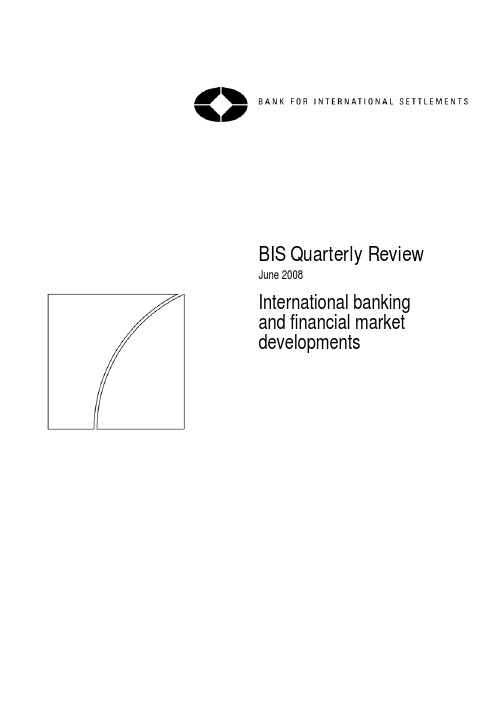
BIS Quarterly ReviewJune 2008 International banking and financial market developmentsBIS Quarterly ReviewMonetary and Economic DepartmentEditorial Committee:Claudio Borio Frank Packer Paul Van den BerghWhite Már Gudmundsson Eli Remolona William Robert McCauley Philip TurnerGeneral queries concerning this commentary should be addressed to Frank Packer(tel +41 61 280 8449, e-mail: frank.packer@), queries concerning specific parts to theauthors, whose details appear at the head of each section, and queries concerning the statisticsto Philippe Mesny (tel +41 61 280 8425, e-mail: philippe.mesny@).Requests for copies of publications, or for additions/changes to the mailing list, should be sent to:Bank for International SettlementsPress & CommunicationsCH-4002 Basel, SwitzerlandE-mail: publications@Fax: +41 61 280 9100 and +41 61 280 8100This publication is available on the BIS website ().©Bank for International Settlements 2008. All rights reserved. Brief excerpts may be reproduced or translated provided the source is cited.ISSN 1683-0121 (print)ISSN 1683-013X (online)BIS Quarterly ReviewJune 2008International banking and financial market developmentsOverview : a cautious return of risk tolerance (1)Credit market turmoil gives way to fragile recovery (1)Box: Estimating valuation losses on subprime MBS with theABX HE index – some potential pitfalls (6)Bond yields recover as markets stabilise (8)A turning point for equity prices? (11)Emerging market investors discount growth risks (12)Tensions in interbank markets remain high (13)Highlights of international banking and financial market activity (17)The international banking market (17)The international debt securities market (23)Derivatives markets (24)Box: An update on local currency debt securities marketsin emerging market economies (28)Special featuresInternational banking activity amidst the turmoil (31)Patrick McGuire and Goetz von PeterThe build-up of international bank balance sheets (32)Developments in the second half of 2007 (36)Bilateral exposures of national banking systems (39)Concluding remarks (42)Managing international reserves: how does diversification affect financial costs? 45 Srichander RamaswamyFramework of the analysis (46)Risk-return trade-offs (48)Financial cost of acquiring reserves through FX intervention (49)Box: Methodology for computing estimates of financial cost (51)Central bank objectives and FX reserve allocation (53)Conclusions (54)Credit derivatives and structured credit: the nascent markets of Asiaand the Pacific (57)Eli M Remolona and Ilhyock ShimCredit default swaps (58)Traded CDS indices (60)Collaterised debt obligations (61)How the region’s markets have fared in the global turmoil (63)Conclusion (65)Asian banks and the international interbank market (67)Robert N McCauley and Jens ZukunftAsian banks’ international interbank liquidity: where do we stand? (68)Foreign banks and the local funding gap (73)Box: The Asian financial crisis: international liquidity lessons (76)Conclusions (78)BIS Quarterly Review, June 2008 iiiRecent initiatives by Basel-based committees and groupsBasel Committee on Banking Supervision (81)Joint Forum (84)Financial Stability Forum (87)Statistical Annex ........................................................................................ A1 Special features in the BIS Quarterly Review ................................ B1 List of recent BIS publications .............................................................. B2Notations used in this Reviewe estimatedlhs, rhs left-hand scale, right-hand scalemillionbillion thousand… notavailableapplicable. not– nil0 negligible$ US dollar unless specified otherwiseDifferences in totals are due to rounding.iv BIS Quarterly Review, June 2008BIS Quarterly Review, June 20081Ingo Fender +41 61 280 8415ingo.fender@Peter Hördahl+41 61 280 8434peter.hoerdahl@Overview: a cautious return of risk toleranceFollowing deepening turmoil and rising concerns about systemic risks in the first two weeks of March, financial markets witnessed a cautious return of investor risk tolerance over the remainder of the period to end-May 2008. The process of disorderly deleveraging which had started in 2007 intensified from end-February, with asset markets becoming increasingly illiquid and valuations plunging to levels implying severe stress. However, markets subsequently rebounded in the wake of repeated central bank action and the Federal Reserve-facilitated takeover of a large US investment bank. In sharp contrast to these favourable developments, interbank money markets failed to recover, as liquidity demand remained elevated.Mid-March was a turning point for many asset classes. Amid signs of short covering, credit spreads rallied back to their mid-January values before fluctuating around these levels throughout May. Market liquidity improved, allowing for better price differentiation across instruments. The stabilisation of financial markets and the emergence of a somewhat less pessimistic economic outlook also contributed to a turnaround in equity markets. In this environment, government bond yields bottomed out and subsequently rose considerably. A reduction in the demand for safe government securities contributed to this, as did growing perceptions among investors that the impact from the financial turmoil on real economic activity might turn out to be less severe than had been anticipated. Emerging market assets, in turn, performed broadly in line with assets in the industrialised economies, as the balance of risk shifted from concerns about economic growth to those about inflation.Credit market turmoil gives way to fragile recoveryFollowing two weeks of increasingly unstable conditions in early March, credit markets were buoyed by a cautious return of risk tolerance, with spreads recovering from the very wide levels reached during the first quarter of 2008. Sentiment turned in mid-March, following repeated interventions by the Federal Reserve to improve market functioning and to help avert the collapse of a major US investment bank. As these actions alleviated earlier concerns about risks to the financial system, previously dysfunctional markets resumed trading and prices rallied across a variety of risky assets.2BIS Quarterly Review, June 2008Between end-February and end-May, the US five-year CDX high-yield index spread tightened by about 144 basis points to 573, while corresponding investment grade spreads fell by 63 basis points to 102. European and Japanese spreads broadly mirrored the performance of the major US indices, declining by between 25 and 153 basis points overall. Between 10 and 17 March, all five major indices had been pushed out to or near the widest levels seen since their inception. They then rallied back and seemed to stabilise around their mid-January values, remaining significantly above the levels prevailing before the start of the market turmoil in mid-2007 (Graph 1).business lines, tightening repo haircuts caused a number of hedge funds and other leveraged investors to unwind existing positions. As a result, concerns underlying exposures are almost entirely protected by federal guarantees, as summer of 2007 (Graph 3, right-hand panel).BIS Quarterly Review, June 20083Fears about collapsing financial markets reached a peak in the week March, triggering repeated policy actions by the US authorities. investment grade credit default swap (CDS) indices underperforming lower-quality benchmarks (Graph 4, left-hand and centre panels). Spreads were temporarily arrested when, on 11 March, the Federal Reserve announced an expansion of its securities lending activities targeting the large US dealer banks (see section on money markets and Table 1 below). European CDS indices tightened by more than 10 basis points on the news, while the two key basis points down, respectively (Graph 1). allowing it to make secured advance payments to the troubled investment These developments appeared to herald a turning point in the market, funds target down to 2.25%. Earnings announcements by major investment banks on 18 and 19 March that were better than anticipated provided further support, with investors increasingly adopting the view that various central bank initiatives aimed at reliquifying previously dysfunctional markets were gradually gaining traction. Consistent with perceptions of a considerable reduction in systemic risk, spreads, and particularly those for financial sector and other investment grade firms, tightened from the peaks reached in early March(Graph 4). Movements were partially driven by the unwinding of speculative short positions, as suggested by changes in pricing differentials across products with similar exposures, according to the ease with which such positions can be opened or closed. For example, spreads on CDS contracts referencing the major credit indices moved more strongly than those on the same indices’ constituent names (Graph 1, centre and right-hand panels). Similarly, CDS markets outperformed those for comparable cash bonds, as market participants adjusted their synthetic trades.risks (Graph 1, centre and right-hand panels). Similarly, implied volatilities from CDS index options eased into the second quarter, indicating a somewhat reduced uncertainty about shorter-run credit spread movements (Graph 3, centre and right-hand panels).losses based on ABX prices (see box). This was despite the lack of a recovery for the index series with lower original ratings, whose prices continued to4 BIS Quarterly Review, June 2008BIS Quarterly Review, June 20085suggest expectations of complete writedowns of all underlying bonds by mid-2009 (Graph 2, centre panel). At these low levels, and with none of the ABX indices having experienced any principal writedowns so far, investors appeared to be pricing in the possibility of legislation writing down mortgage principal. Against this background, issuance of private-label mortgage-backed securities remained depressed, with volume growth coming mainly from US agency-Supported by optimism about banks’ recapitalisation efforts, spreads pace of capital replenishment. Following news of a rights issue on 31 March, CDS spreads referencing debt issued by Lehman Brothers tightened. UBS announced large first quarter losses and a fully underwritten capital increase on 1 April, and other institutions followed over the rest of the month. Globally, banks managed to raise more than $100 billion of new capital in April alone, stemming the deterioration in capital ratios. Financial CDS spreads, the monoline segment excluded, outperformed corresponding equity prices in the process (Graph 4, right-hand panel), reflecting diminishing concerns about imminent financial sector risk as well as the dilutory effects of equity financing. Markets retraced some of these gains in early May, partially driven by strong supply flows from corporate issuers that included, at $9 billion, the largest US dollar deal by a non-US borrower in seven years. Volumes were dominated by6 BIS Quarterly Review, June 2008Pitfalls in using the ABX. Estimated mark to market losses and actual writedowns made by banks and other investors can differ for a variety of reasons. Analysts, depending on their objective, thus have to be mindful of potential sources of bias. At least three such sources can be identified, of which two are specific to the ABX index:•Accounting treatment. Subprime MBS are held by a variety of investors and for different purposes. While large amounts of outstanding subprime MBS are known to reside inbanks’ trading books, banks and other investors may also hold these securities tomaturity. This can result in different accounting treatments, which would tend to deflateactual writedowns and impairment charges relative to estimates of mark to market losseson the basis of market indices, such as the ABX. The size of this effect, however, isdifficult to determine. Further complexities are added once securities cease to be tradedin active markets, implying the use of valuation techniques, which may differ acrossinvestors, in establishing fair value.5•Market coverage. ABX prices may not be representative of the total subprime universe, due to limited index coverage of the overall market. Original balance across all four serieshas averaged about $31 billion. This compares to average monthly MBS issuance ofsome $36 billion over the 10 quarters up to mid-2007, ie almost a month’s worth ofsubprime MBS supply per index series. Similarly, with 2004–07 vintage subprime MBSvolumes estimated at around $600 billion in outstanding amounts, each series representssome 5% of the overall universe on average. At the same time, ABX deal composition isknown to be quite similar in terms of collateral attributes (such as FICO scores and loan-to-value ratios) to the overall market (by vintage).6 Therefore, despite somewhat limitedcoverage, this particular source of bias may not be large.•Deal-level coverage. Similarly, ABX prices may not be representative because each index series covers only part of the capital structure of the 20 deals included in the index(see Graph A, right-hand panel, for an illustration).7 In particular, tranches referenced bythe AAA indices are not the most senior pieces in the capital structure, but those with thelongest duration (expected average life) – the so-called “last cash flow bonds”. Theseclaims will receive any cash flow allocations sequentially after all other AAA trancheshave been paid; and tend to switch to pro rata pay only when the highest mezzaninebond has been written down. It follows that AAA ABX index prices are going to reflectdurations that are longer, and effective subordinations that are lower, than those of theremaining AAA subprime MBS universe. As a result, using newly available data for MBStranches with shorter durations, the $119 billion of losses implied by the ABX AAA indicesas of end-May would be some 62% larger than those implied under more realisticassumptions.8_________________________________1 See, for example, International Monetary Fund, Global Financial Stability Report, April 2008, pp 46–52, and Box 1 in Bank of England, Financial Stability Report, April 2008.2 Supplementary indices, called ABX HE PENAAA, were introduced in May 2008 to provide additional pricing information for all four existing vintages.3 An alternative approach, likely to lead to very different results, would estimate future default-related cash flow shortfalls on the basis of deal-level or aggregate data for subprime securities. To obtain these estimates, such methodologies rely on information about collateral performance and require the analyst to make assumptions about structural relationships and model parameters. Typical subprime loss projections, for example, use delinquency data and assumptions about factors such as delinquency-to-default transitions, default timing, and losses-given-default. See Box 1 in the Overview section of the December 2007 BIS Quarterly Review for an example on the basis of an approach devised by UBS. 4Mark to market losses (relative to par) are calculated assuming that unrated tranches are written down completely; ABX prices for the BBB– indices are used to mark BB collateral; rated tranches from the 2004 vintage are assumed unimpaired; outstanding amounts remain static.5 For details, see Global Public Policy Committee, Determining fair value of financial instruments under IFRS in current market conditions, December 2007.6 See, for example, UBS, Mortgage Strategist, 17 October 2006. 7 Incomplete coverage at the deal level further reduces effective market coverage: typical subprime MBS structures have some 15 tranches per deal, of which only five were originally included in the ABX indices. As a result, each series references less than 15% of the underlying deal volume at issuance.8 Duration effects at the AAA level are bound to be significant for overall loss estimates as the AAA classes account for the lion’s share of MBS capital structures. Using prices for the newly instituted PENAAA indices, which reference “second to last” AAA bonds, to calculate AAA mark to market losses generates an estimate of $73 billion. This, in turn, translates into an overall valuation loss of $205 billion (ie some 18% below the unadjusted estimate of $250 billion).capitalisation had recovered, while remaining weaker than before the crisis. At the same time, still-elevated implied volatilities suggested ongoing investor uncertainty over the future trajectory of credit markets. With the credit cycle continuing to deteriorate and related losses on exposures outside the residential mortgage sector looming, it was thus unclear whether liquidity supply and risk tolerance had recovered to an extent that would help maintain this improved environment on a sustained basis.Bond yields recover as markets stabiliseFrom its low point on 17 March, the 10-year US Treasury bond yield rose by 75 basis points to reach 4.05% at the end of May. During this period, 10-year yields in the euro area and Japan climbed by around 70 and 50 basis points, respectively, to 4.40% and 1.75% (Graph 5, left-hand panel). In US and euro area bond markets, the increase in yields was particularly pronounced for short maturities, with two-year yields rising by 130 basis points in the United States and by almost 120 basis points in the euro area (Graph 5, centre panel). Two-year yields went up in Japan too, but by a more modest 35 basis points. In addition to reduced safe haven demand for government securities, the rise in short-term yields reflected a reassessment among investors of the need for monetary easing, following the stabilisation of financial markets.In the first two weeks of March, as the financial turmoil deepened and forward rates dropping (Graph 6, right-hand panel). While flight to safety and other effects relating to the volatility in financial markets may have influenced consistent with the observed fall at the short end of the forward break-evencurve. At the same time, these same concerns led investors to increasinglyexpect the Federal Reserve to maintain a more accommodative policy stancethan normal in an effort to contain the fallout on economic growth. Insofar asthis was seen as likely to lead to higher prices down the road, it could explainthe rise in distant forward break-even rates at the time.As the situation in financial markets stabilised after the rescue of BearStearns in mid-March, and perceptions of the economic outlook improvedsomewhat, the US forward break-even curve shifted in the opposite directionand flattened considerably. To a large extent, this shift in the forward curve islikely to have reflected a reversal of the same influences that had been at playin the first two weeks of March: the dampening effect on prices coming from theturmoil was perceived to be weaker after mid-March, while the Federal Reservewas seen to be less likely to deliver further sharp rate cuts. Moreover, upwardprice pressures appeared to intensify in the short to medium term, with foodprices rising continuously and oil prices reaching new all-time highs during thisperiod (Graph 5, right-hand panel), pushing near-term forward break-evenrates further upwards.real yields reflected a combination of expectations of higher average realinterest rates in coming years and a reversal of flight to safety pressures. Theformer component, in turn, was due to perceptions among investors that thereal economic fallout from the financial turmoil was likely to be less severe thanhad previously been anticipated. This was despite indications of deterioratingconsumer confidence amid tighter bank lending standards and continuedweakness in US housing markets. The revival in investor confidence seemedinstead to follow from the stabilisation in markets and from a number ofrelatively upbeat macroeconomic announcements. These included better thangovernment securities.In line with perceptions that the stabilisation of markets had reduced therisks to economic growth somewhat, prices of short-term interest rateindicating expectations of a period of stable rates, followed by rising rates inthe first half of 2009 (Graph 7, left-hand panel). In the euro area, EONIA swapprices at the beginning of March had signalled expectations of sizeable ECBrate cuts, but by end-May prices had shifted to reflect expectations of graduallyincreasing policy rates (Graph 7, centre panel). Meanwhile in Japan,expectations of mildly falling policy rates in March had by May been revised toindicate rising rates (Graph 7, right-hand panel).A turning point for equity prices?to end-2007 levels, gained almost 10% between 17 March and end-May. Equity markets in Europe and Japan, which had seen losses in excess of 20% between the turn of the year and 17 March, subsequently also displayed a strong recovery, with the EURO STOXX gaining 11% and the Nikkei 225 rising Reflecting the improved situation in financial markets during this period, by almost 20% and 34%, respectively. These gains occurred despiteannouncements by several banks of record losses during the first quarter amidcontinued credit-related write-offs. Investors obviously took solace from the factthat losses – although big – were no worse than expected, and that a numberof banks had been successful in their recapitalisation efforts (see credit marketsection above).surprises remained well above that of negative surprises, provided somesupport for equity prices. In addition, as fears failed to materialise that economic growth might slow dramatically in the first few months of the year,investors increasingly began to see equity valuations as attractive following thesharp price declines in late 2007 and early 2008. markets recovered after a sharp dip in March (Graph 8, right-hand panel).Emerging market investors discount growth risksequities fell up to mid-March, before rebounding in the wake of the change inmarket sentiment following the Bear Stearns rescue in the United States.Between end-February and end-May, the MSCI emerging market indexgained about 4% in local currency terms, and was up more than 14% from thelows established in mid-March. Latin American markets, which had seen ahigh trading volumes in commodity derivatives (see the Highlights section inthis issue) and speculative demand as a source of part of that strength, otherspointed to low supply elasticities and expectations of sustained rates ofindustrialisation throughout the emerging markets. With the region being amajor net commodities importer and natural disaster contributing to weakerequity prices in China, Asian markets were broadly flat over the period.Emerging Europe, in turn, remained exposed to the risk of a reversal in privatecapital flows, owing to large current account deficits and associated financingneeds in a number of countries. Nevertheless, strong gains in Russia and thebetter than expected growth performance of major European economies in thefirst quarter seemed to aid equity markets in May.Emerging market credit spreads, as measured by the EMBIG index,accounting for most of the spread tightening, the EMBIG remained almost flatin return terms, gaining about 1.1% between end-February and end-May(Graph 9, left-hand panel). Large stocks of foreign reserves and favourablemacroeconomic performance in key emerging market economies continued toprovide support, aiding the market recovery. Spread dispersion remained high,pointing to ongoing price differentiation according to credit quality (Graph 10,centre panel). At the same time, with inflation running well above target in anumber of major emerging market economies, policy credibility appeared tobecome more of a concern, putting pressure on local bond markets. Risinginflation expectations, combined with increasing US Treasury yields andrelatively resilient markets during the earlier stages of the recent marketturmoil, may thus have contributed to a somewhat more muted performancefrom emerging market bonds relative to other asset markets over the periodsince mid-March.Tensions in interbank markets remain highas high at the end of May as three months earlier, across most horizons and inall three major markets (Graph 10). This appeared to imply expectations thatinterbank strains were likely to remain severe well into the future.After a relatively smooth turn of the year, interbank market tensions hadappeared to ease somewhat until early March 2008, and Libor-OIS spreadshad shown some signs of stabilising. However, as the financial turmoilsuddenly deepened in the second week of March, following an acceleration inmargin calls and rapid unwinding of trades (see the credit section above),interbank market pressures quickly increased. With market rumoursproliferating about imminent liquidity problems in one or more large investmentbanks, banks became increasingly wary of lending to others. At the same time,their own demand for funds jumped as they sought to avoid being perceived ashaving a shortage of liquidity.Selected central bank liquidity measures during the period under review7 March The Federal Reserve increases the size of its Term Auction Facility (TAF) to $100 billion andextends the maturity of its repos to up to one month.11 March The Federal Reserve introduces the Term Securities Lending Facility (TSLF), which allowsprimary dealers to borrow up to $200 billion of Treasury securities against collateral. Theexisting dollar swap arrangements between the Federal Reserve and the ECB and the SNB areincreased from a total of $24 billion to $36 billion.16 March The Federal Reserve introduces the Primary Dealer Credit Facility (PDCF), which providesovernight funding for primary dealers in exchange for collateral. The Federal Reserve alsolowers the spread between the discount rate and the federal funds rate from 50 to 25 basispoints, and lengthens the maximum maturity from 30 to 90 days.28 March The ECB announces that the maturity of its longer-term refinancing operations (LTROs) wouldbe extended from up to three months to a maximum of six months.21 April The Bank of England introduces the Special Liquidity Scheme, under which banks can swapilliquid assets for Treasury bills.2 May The Federal Reserve boosts the size of its TAF programme to $150 billion, and announces abroadening of the collateral eligible for the TSLF auctions. The dollar swap arrangements withthe ECB and the SNB are increased further, from $36 billion to $62 billion.Source: Central bank press releases. Table 1The near collapse and subsequent takeover of Bear Stearns onMarch highlighted the risks that banks face in such situations. On the would not be allowed to fail, and this helped restore order in other markets. On the other hand, the speed with which Bear Stearns’ access to market liquidity had collapsed underscored the vulnerability of other banks in this regard, which kept Libor-OIS spreads high even as CDS spreads on banks and brokerages Throughout the period, central banks maintained and even stepped up activity from central banks seemed to have limited immediate impact oninterbank rates. To some extent, this may have reflected the fact that while thesums involved in central bank liquidity schemes were large in absolute terms,they were still rather limited compared to banks’ assessment of their overallliquidity needs against the background of a sharp decline in traditional sourcesof funding. One significant source of short-term funding for banks in the pasthas been money market mutual funds. Such funds have seen substantialinflows since the outbreak of the financial turmoil (Graph 11, left-hand panel),reflecting a noticeable reduction in investors’ appetite for risk. However, thisloss of risk appetite also resulted in money market funds shifting theirinvestments increasingly into treasury bills and other safe short-term securities,hence depriving banks of a key funding source (Graph 11, centre panel). Thissuggests that determining how persistent the interbank tensions will be maydepend significantly, among other things, on how long the risk appetite ofmoney market fund managers, and investors more broadly, will continue to bedepressed.。
谢狂飞四六级英语讲座资料
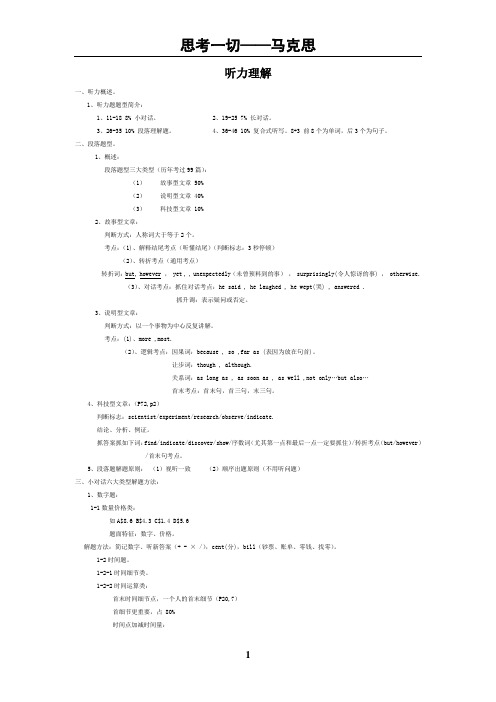
听力理解一、听力概述。
1、听力题题型简介:1、11-18 8% 小对话。
2、19-25 7% 长对话。
3、26-35 10% 段落理解题。
4、36-46 10% 复合式听写。
8+3 前8个为单词,后3个为句子。
二、段落题型。
1、概述:段落题型三大类型(历年考过99篇):(1)故事型文章 50%(2)说明型文章 40%(3)科技型文章 10%2、故事型文章:判断方式:人称词大于等于2个。
考点:(1)、解释结尾考点(听懂结尾)(判断标志:3秒停顿)(2)、转折考点(通用考点)转折词:but, however , yet , , unexpectedly(未曾预料到的事), surprisingly(令人惊讶的事) , otherwise.(3)、对话考点:抓住对话考点:he said , he laughed , he wept(哭) , answered .抓升调:表示疑问或否定。
3、说明型文章:判断方式:以一个事物为中心反复讲解。
考点:(1)、more ,most.(2)、逻辑考点:因果词:because , so ,far as (表因为放在句首)。
让步词:though , although.关系词:as long as , as soon as , as well ,not only…but also…首末考点:首末句,首三句,末三句。
4、科技型文章:(P72,p2)判断标志:scientist/experiment/research/observe/indicate.结论、分析、例证。
抓答案抓如下词:find/indicate/discover/show/序数词(尤其第一点和最后一点一定要抓住)/转折考点(but/however)/首末句考点。
5、段落题解题原则:(1)视听一致(2)顺序出题原则(不用听问题)三、小对话六大类型解题方法:1、数字题:1-1数量价格类:如A$8.6 B$4.3 C$1.4 D$5.6题面特征:数字、价格。
最新伯南克第一课英文讲义

伯南克第一课英文讲义北京时间3月21日凌晨,美联储主席伯南克稍早时在乔治-华盛顿大学商学院进行了针对该院学生系列讲座的第一讲,题目为:美联储的基本使命。
以下是伯南克本次讲座的英文讲义全文。
(资料来源于美联储网站)The Federal Reserve and the Financial CrisisOrigins and Mission of the Federal Reserve, Lecture 1George Washington University School of BusinessMarch 20, 2012, 12:45 p.m。
[Applause]President Steve Knapp: Well, good afternoon. I think the students here may know who I am but for those who are watching the broadcast, I'm Steve Knapp, President of George Washington University. And it's really a pleasure to welcome you to today's first class in the series entitled Reflections on the Federal Reserve and its place in today's economy, featuring the Chairman of the Federal Reserve, Dr. Ben Bernanke. I'm pleased to acknowledge that we have with us two of the university's trustees, Nelson Carbonell and Mark Shenkman, and also a number of faculty members are here in the audience and some of them will be teaching later in the series. Today is the first university lecture series delivered by a sitting Chairman of the Federal Reserve. I think it does provide an extraordinary opportunity for the students who are here in the classroom, but also for those watching online. They have an opportunity to gain insight into the nation's central banking system and a wide range of issues that affect this country and the world. I do want to say that there are microphones available for the students, and certainly encourage you when the Chairman's lecture is over to avail yourself of those and we hope there'll be a lively exchange of questions and answers at the end of the lecture. It's now a distinct honor to introduce the Chairman of the Board of Governors of the Federal Reserve System, Dr. Ben Bernanke. Dr. Bernanke took office in 2006, and is now serving a second term as Chairman. He also serves as Chairman of the Federal Reserve's Open Market Committee. Before his appointment as Chairman, Dr. Bernanke was involved with the Federal Reserve in several roles as a Member of the Board of Governors, as a visiting scholar, and as a member of the Academic Advisory Panel at the Federal Reserve Bank of New York. He also served as Chairman of the President's Council of Economic Advisers from June 2005 to January 2006.Now Chairman Bernanke is no stranger to academia. He's been a faculty member at Princeton, Stanford and New York University, as well as the Massachusetts Institute of Technology. He's held a Guggenheim and a Sloan Fellowship, and is a fellow of the Econometric Society and the American Academy of Arts and Sciences. Chairman Bernanke received a Bachelor of Arts from Harvard University and a PhD from MIT. Ladies and gentlemen, please join me inwelcoming Chairman of the Federal Reserve, Dr. Ben Bernanke.[ Applause ]Chairman Ben Bernanke: Thank you very much, President Knapp. Gee, this is great. This is what I used to do before I got in this line of work for 23 years and I've always enjoyed engaging with college students. So thank you for being here, and I hope we do have a good conversation. Let me particularly thank President Knapp and Professor Fort and George Washington University. As everybody here knows, these lectures are part of a real course and after I get off the scene there will be other professors talking about other aspects of the Fed and you'll hear different points of view which is great. And you'll have to do some papers and all those kinds of things and I'm going to read a few of the paper. So, I look forward to doing that.So, I'll be talking from slides, which is in part for the purpose of making this available to others who might be interested. These slides will be posted on the Federal Reserve's website, , as we go through. And so, if you need extra copies, by all means do that. And as President Knapp said, I'm going to be talking for a while from the presentation but at the end, I hope we can have some questions and answers.So, let me get started. So what I want to talk about in these four lectures is the Federal Reserve and the financial crisis. Now, my thinking about this is very much conditioned by my experience as an economic historian. I think when you talk about the issues that just occurred of the last few years, it makes the most sense to think about it in the broader context of central banking as its taking place over the centuries. So, even though we're going to be focusing a good bit of the lectures, particularly next week, on the financial crisis and how the Fed responded. I think we need to go back and look at the broader context. So, as we talk about the Fed we'll be talking about the origin and mission of central banks in general, and we're looking at previous financial crises, most notably the Great Depression, and see how that informed the Fed's actions and decisions in the recent crisis. So let me just give you a roadmap of the four lectures. Today, lecture one, we won't touch on the current crisis at all. Instead, we'll talk about what central banks are, what they do, how central banking got started in the United States and we'll do some history. We'll talk about how the Fed engaged with its first great challenge, the Great Depression of the 1930s. The second lecture on Thursday, we'll take up the history. We'll review developments in central banking and with the Federal Reserve after World War II talking about the conquest of inflation, the great moderation and other developments that occurred after World War II. But we'll spend a good bit of time lecture two, in lecture two, talking about the build-up to the crisis and some of the factors that led to the crisis of 2008, 2009.Then next week, we'll get into the more recent events. In lecture three, we'll talk about the intense phase of the financial crisis, its causes, its implications, and particularly, the response to the crisis by the Federal Reserve and by other policymakers. And then, in the final lecture, lecture four, we'll look at the aftermath. We'll talk about the recession that followed the crisis, the policy response of the Fed including monetary policy, the broader response in terms of the changes in financial regulation, and a little bit of forward-looking discussion about how this experience willchange how central banks operate and how the Federal Reserve will operate going forward. So this is our topic today is origins and missions of the Federal Reserve. So let's talk in general about what a central bank is. If you've had some background in economics you know that a central bank is not a regular bank, it's a government agency, and it stands at the center of the monetary and financial system of a country. Central banks are very important institutions, they have helped to guide the development of modern financial systems, modern monetary systems and they play a major role in economic policy. Now, we've had various arrangements over the years but today, virtually, all countries have central banks. The Federal Reserve in the United States, the Bank of Japan in Japan, Bank of Canada, and so on. The main exception is only cases where you have what's called a currency union where a number of countries collectively share a central bank. The most important example by far of that is the European Central Bank which is central bank to 17 European countries who share the common currency, the Euro. But even in that case, each of the participating countries does have its own central bank which is part of the overall system of the Euro. So central banks are now ubiquitous, even the smallest countries typically have central banks. Now, this is a very important theme here, what do Central Banks do? What is their mission? And as I'll discuss throughout the lectures, it's convenient to talk about two broad aspects of what central banks do. The first is to try to achieve macroeconomic stability. And by that, I generally mean stable growth in the economy, avoiding big swings, recessions and the like, and keeping inflation low and stable. So that's the economic function of a central bank. The other function of central banks, which is going to get a lot of attention, obviously, in these lectures, is the financial stability function. Central banks try to keep the financial system working normally and in particular, they either, they try to prevent or if unsuccessful in preventing they try to mitigate financial panics or financial crises. And I'll talk more about what those are. Now what are the tools that central banks use to achieve these two broad objectives? Very, in very simple terms, there are basically two broad sets of tools. On the economic stability side, the main tool as I'm sure everyone knows is monetary policy. In normal times, the Fed, for example, can raise or lower short-term interest rates. It does that by buying and selling securities in the open market. And again, in normal times, if the economy is growing too slowly or inflation is falling too low, the Fed can stimulate the economy by lowering interest rates. Lower interest rates feed through to a broad range of other interest rates that encourages spending, acquisition of homes for example, construction, investment by firms, borrowing. It just generates more demand, more spending and more investment in the economy, and that creates more thrust in growth so that to stimulate an economy, you lower interest rates. And similarly, if the economy is growing too hot, if inflation is becoming a problem, then the normal tool of central bank is to raise interest rates. So by raising the overnight interest rate, known in the United States as the federal funds rate, higher interest rates feed through the system and help to slow the economy by raising the cost of borrowing, of buying a house, of buying a car, or of investing in capital goods and that will slow the economy and reduce pressure of overheating. So, monetary policy is the basic tool that central banks have used for many, many years to try to keep the economy at a more or less even keel in terms of both growth and inflation.Now, a little less familiar is the main tool of central banks in dealing with financial panics or financial crises. And that tool is the provision of liquidity. So to address financial stability concerns and for reasons I'll explain, one thing that central banks can do is make short-term loansto financial institutions. As I'll explain, providing short-term credit to financial institutions during a period of panic or crisis can help calm the market, can help stabilize those institutions and can help mitigate or bring to an end a financial crisis. So this activity which is an old one, as I'll discuss, is known as the lender of last resort tool. So again, if financial markets are disrupted, financial institutions don't have alternative sources of funding, then the central bank stands ready to service the lender of last resort providing liquidity to the system and thereby helping to stabilize the financial system.Now, there's a third tool which the Fed has had from the beginning and most central banks have which is financial regulation and supervision. Central banks usually play a role in supervising the banking system, assessing the extent of risk on their portfolios, making sure their practices are sound, and in that way, trying to keep the financial system healthy. To the extent that financial system can be kept healthy and its risk-taking within reasonable bounds, then the chance of a financial crisis occurring in the first place is reduced. However, this activity, and I will come back to it, this is something which is not unique to central banks. In the United States, for example, there are a number of different agencies, like the FDIC or the Office of the Comptroller of the Currency that work with the Fed in supervising the financial system. So this is not unique to central banks and so I'll be down playing this for the time being and focusing on the two principle tools, monetary policy and lender of last resort activities.Now, where do central banks come from? One thing people don't appreciate, I think, is that central banking is not a new development. It's been around for a very long time. The Swedes set up a central bank in 1668, three and a half centuries ago. The Bank of England was founded in 1694 and that of course for many decades or if not centuries was the most important and influential central bank in the world, and France in 1800. So, central bank theory and practice is, again, not a new thing. We have been thinking about these issues collectively as an economics profession and in other contexts for many, many years. Now, I've exaggerated slightly in a sense that, say, the Bank of England in 1694 wasn't set up from scratch, it's a full-fledged central bank, it was originally a private institution. And over time, it acquired some of the functions of a central bank such as issuing money or serving as lender of last resort. But over time, these central banks became essentially government agencies, government institutions as they all are today. Certainly, one important responsibility of central banks for much of the period that I'm talking about was to manage the gold standard to issue paper money that was backed by gold and I'll talk more about gold in a few moments.Now, the lender of last resort function, which I mentioned earlier, became important in the-- mostly in the 19th century. Early in the 19th century, the Bank of England was doing a lot of this type of activity and they became very good at it. And as we'll see, while the United States was suffering with banking panics in the latter part of the 19th century, banking panics in the United Kingdom were quite rare. So the Bank of England sort of set the pace in some sense. It was the most important central bank and it helped establish the practices and the approaches that we still use today. Now, I need to talk a little bit because it's less familiar about what a financial panic is. In general, a financial panic is sparked by a loss of confidence in an institution and I think the best way to explain this is to give a familiar example. How many of you have ever seen the movie "It'sa Wonderful Life"? No? Less people are watching Christmas movies than they used to be, I guess [laughter]. Well, one of the probl ems that Jimmy Stewart runs into as a banker in “It’s a Wonderful Life” is a threatened run on his institution. And what is a run? Well, let's imagine a situation like Jimmy Stewart's situation before there was any deposit insurance, no FDIC. And imagine you have a bank on the corner, just a regular commercial bank, the first bank of Washington, D.C., and this bank makes loans to businesses and the like, and it finances itself by taking deposits from the public and deposits are demand deposits, which means that anybody can pull out their money anytime they want which is important because people use deposits for ordinary activities, like shopping.Now imagine what would happen if for some reason, a rumor goes around that this bank has made some bad loans and is losing money. As a depositor, you say to yourself, "Well, I don't know if this rumor is true or not。
BORANG PENGESAHAN STATUS TESIS
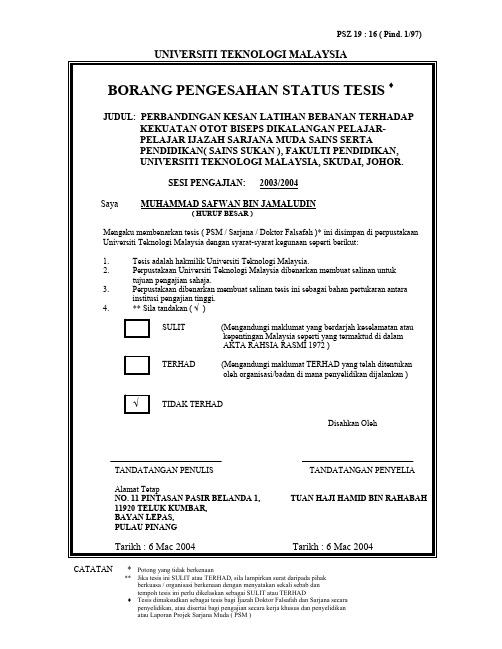
PSZ 19 : 16 ( Pind. 1/97)CATATAN * Potong yang tidak berkenaan** Jika tesis ini SULIT atau TERHAD, sila lampirkan surat daripada pihakberkuasa / organisasi berkenaan dengan menyatakan sekali sebab dantempoh tesis ini perlu dikelaskan sebagai SULIT atau TERHAD♦ Tesis dimaksudkan sebagai tesis bagi Ijazah Doktor Falsafah dan Sarjana secarapenyelidikan, atau disertai bagi pengajian secara kerja khusus dan penyelidikanatau Laporan Projek Sarjana Muda ( PSM )Saya akui bahawa saya telah membaca karya ini danpada pandangan saya karya ini adalah memadai dari segi skop dan kualiti untuk tujuan penganugerahan Ijazah Sarjana Muda Sains Serta Pendidikan ( Sains Sukan ):………………………………………TandatanganTuan Haji Abdul Hamid Bin RahabahPenyelia :Nama6 Mac 2004Taraikh :PERBANDINGAN KESAN LATIHAN BEBANAN TERHADAP KEKUATAN OTOT BISEPS DIKALANGAN PELAJAR-PELAJAR IJAZAH SARJANA MUDA SAINS SERTA PENDIDIKAN ( SAINS SUKAN ), FAKULTI PENDIDIKAN, UNIVERSITI TEKNOLOGI MALAYSIA, SKUDAI JOHORMUHAMMAD SAFWAN BIN JAMALUDINLaporan Projek Ini DikemukakanSebagai Memenuhi Sebahagian Daripada Syarat PenganugerahanIjazah Sarjana Muda Sains Serta Pendidikan ( Sains Sukan )Fakulti PendidikanUniversiti Teknologi Malaysia6 Mac 2004Saya akui karya ini adalah hasil kerja saya sendirikecuali nukilan dan ringkasan yang tiap-tiap satunyatelah saya jelaskan sumbernya.Tandatangan : …………………………………… Nama Penulis : Muhammad Safwan Bin Jamaludin Tarikh : 6 Mac 2004DEDIKASITeristimewa ditujukan buat Baba dan Mama yang dikasihi,Jamaludin Bin Mohd AliKhalijah Binti YaacobTerima kasih diatas berkat doa, semangat, doronganserta keyakinan yang diberikan agar anakmu ini terusberusaha dan berjaya dalam pelajaran.Teristimewa juga diucapkan kepadaRoseliza Binti Rawi @ Che Tehkerana banyak memberi galakan daninspirasi kepada diri ini.Tidak lupa juga kepada rakan-rakan seperjuangan Akhtar, Zaki, Ujang, Pok Nik, Dino, Soffri, Muthu, Azrul dan WanPENGHARGAANDengan nama Allah Yang Maha Pemurah lagi Maha Mengasihani, saya mengambil kesempatan ini untuk mengucapkan ribuan terima kasih kepada mereka yang terlibat secara langsung atau tidak langsung membantu saya dalam penghasilan kajian ini.Jutaan terima kasih dan setinggi-tinggi penghargaan saya hulurkan kepada Tuan Haji Abdul Hamid Bin Rahabah selaku pensyarah pembimbing bagi penghasilan kajian ini yang telah banyak memberi galakan, nasihat dan panduan yang berguna dalam menyiapkan kajian ini. Tidak lupa juga kepada warga pensyarah-pensyarah Sains Sukan yang lain kerana telah banyak menurunkan ilmu kepada saya semasa pembelajaran saya di Universiti Teknologi Malaysia.Ucapan terima kasih juga saya hadiahkan kepada subjek-subjek yang telah meluangkan masa dan memberi komitmen yang baik bagi menjayakan ujian yang dijalankan serta rakan-rakan yang banyak membantu saya dalam menyiapkan kajian ini.Akhir sekali, segala bantuan dan sokongan serta galakan yang diberikan amatlah saya hargai.ABSTRAKKajian ini bertujuan untuk melihat pengaruh latihan bebanan terhadap kekuatan otot biseps dikalangan pelajar Ijazah Sarjana Muda Sains Serta Pendidikan( Sains Sukan ) yang berumur diantara 20 hingga 28 tahun selama enam minggu dengan kekerapan tiga kali seminggu melalui penggunaan one arm cable curl dan dumbell. Kesemua subjek terdiri daripda lapan orang dan dibahagikan kepada dua kumpulan iaitu kumpulan yang menggunakan one arm cable curl dan dumbell. Kedua-dua jenis latihan ini akan menjalani ujian pra dan ujian pos. Kedua-dua ujian ini akan diukur menggunakan Electromyography I, Standard and Integrated EMG. Data mentah yang diperolehi akan dianalisis menggunakan program “Statistical Packages For Social Science” versi 11.0. Hipotesis dalam kajian ini diuji mengikut penganalisaan secara statistik yang melibatkan ujian t. Hasil daripada dapatan kajian menunjukkan bahawa terdapat perbezaan yang signifikan terhadap kedua-dua jenis latihan. Ini menunjukkan bahawa latihan kekuatan yang diberikan mempengaruhi kekuatan otot biseps.ABSTRACTThe purpose of this research is to find out the effect of weight training towards the strength of biseps among the students of Bachelor of Science and Education (Sport Science), aged between 20 to 28. They trained three times a week for six weeks by using one arm cable curl and dumbell. There were eight subjects divided into two groups. The first group used one arm cable curl and another group used dumbell. Both trainings will be pre and post tested and measured with Electromyography I, Standard and Integrated EMG. The raw data obtained will be analyzed by “Statistical Packages For Social Science” version 11.0 programme. The result of the research is statistically analyzed by using the t-test. The result showed that there is a significant difference for both trainings. This verifies that weight trainings had some effect on the strength of biseps.KANDUNGANBAB PERKARA MUKASURATPenyeliaPengakuanJudulDiri ii PengakuanDedikasi iiiiv PenghargaanAbstrak vAbstract viviiKandunganSenarai Jadual xxi SenaraiRajahxii SenaraiLampiranBAB I PENDAHULUAN11.1Pengenalan41.2PernyataanMasalahKajian 51.3Objektif5Kajian1.4KepentinganKajian 61.5Hipotesis6Operasional1.6Definisi1.7Limitasi Kajian 8BAB II SOROTAN KAJIAN92.1PengenalanBerkaitan 92.2KajianBAB III METODOLOGI KAJIAN18Pengenalan3.119PenyelidikanKaedah3.2PersampelanDan193.3PopulasiKajian 203.4InstrumenKajian 213.5Prosedur253.6RekabentukKajianKajian26Pembolehubah3.7Data27Pengumpulan3.827Data3.9PenganalisaanBAB IV PENGANALISAAN DATA4.1Pengenalan28Diskriptif 294.2Penganalisaan4.3Inferensi 50PenganalisaanPenutup 54 4.4BAB V PERBINCANGAN, KESIMPULAN DAN CADANGANPengenalan555.155Perbincangan5.2575.3KesimpulanCadangan 585.4Penutup 595.5RUJUKAN 60LAMPIRAN 64SENARAI JADUALNO. RAJAH TAJUK MUKASURAT4.2.1 Taburan Bilangan Subjek Mengikut Umur 304.2.2 Taburan Bilangan Subjek Mengikut Berat Badan 324.2.3 Taburan Bilangan Subjek Mengikut Ketinggian 344.2.4 Kekuatan Maksimum Otot Biseps Terhadap 36Penggunaan One Arm Cable Curl Bagi Ujian Pra4.2.5 Kekuatan Maksimum Otot Biseps Terhadap 39Penggunaan One Arm Cable Curl Bagi Ujian Pos4.2.6 Kekuatan Maksimum Otot Biseps Terhadap 43Penggunaan Dumbell Bagi Ujian Pra4.2.7 Kekuatan Maksimum Otot Biseps Terhadap 46Penggunaan Dumbell Bagi Ujian Pos4.3.1 Analisis Kekuatan Otot Biseps Terhadap Penggunaan 50One Arm Cable Curl Antara Ujian Pra Dan Ujian Pos4.3.2 Analisis Kekuatan Otot Biseps Terhadap Penggunaan 52Dumbell Antara Ujian Pra Dan Ujian PosSENARAI RAJAHNO. RAJAH TAJUK MUKASURAT31UmurMengikutPeratusanSubjek12 Peratusan Subjek Mengikut Berat Badan 333 Peratusan Subjek Mengikut Ketinggian 354 Perbandingan Min Skor Ujian Pra Dan Ujian Pos 42PenggunaanOne Arm Cable CurlTerhadap5 Perbandingan Min Skor Ujian Pra Dan Ujian Pos 49DumbellPenggunaanTerhadap6 Kawasan Penerimaan Hipotesis Dan Penolakan 51MenggunakanOne Arm Cable CurlYangSubjek7 Kawasan Penerimaan Hipotesis Dan Penolakan 53DumbellMenggunakanSubjekYangSENARAI LAMPIRANNO. LAMPIRAN TAJUK MUKASURATSubjek 64 A RekodKesihatan65SubjekB KriteriaPemilihanSubjek 66PerlantikanC SuratD Surat Perjanjian 67SubjekEMG68RekodE DataLatihanBebanan 69F JadualLatihan 70AktivitiG Jadualt 71TaburanH SkalaAlat 72I GambarajahPenggunaanJ Analisis ujian t ( T-Test ) Terhadap 74One Arm Cable CurlPenggunaanAnalisis ujian t ( T-Test ) Terhadap 76DumbellPenggunaanBAB 1PENDAHULUAN1.1PengenalanPerkembangan teknologi sukan di alaf baru ini telah banyak mempengaruhi kegiatan sukan yang berbentuk “outdoor” ( sukan terbuka ) mahupun “indoor” ( sukan tertutup ). Dengan ledakan paradigma, jelas menunjukkan sukan sekarang telah mula berkembang dengan pesatnya, sehinggakan kita yang hidup ini tidak dapat mengikuti perkembangannya dari masa ke semasa. Ini kerana semakin kita mengikuti perkembangannya kita akan dapati ledakan kemajuan dan kecanggihan teknologi dalam sukan tidak mungkin ada titik noktahnya.Sukan merupakan suatu aktiviti riadah dan boleh dilakukan sepanjang hayat seseorang itu. Rekreasi juga merupakan suatu aktiviti bagi menjaga kesihatan serta meningkatkan kecergasan Dengan kemudahan teknologi sukan yang ada sekarang, membolehkan kita mudah mendapatkan maklumat melalui media cetak mahupun media massa. Dengan perkembangan teknologi sukan yang ada sekarang ini haruslah direbut dan dikuasai agar pencapaian dan pembangunan sukan tanahair akan mengalami perubahan serta peningkatan yang boleh kita banggakan.Pada masa kini, mudah bagi kita mengikuti kelas-kelas senaman aerobik di gimnasium dan juga menjalani aktiviti kecergasan di tempat-tempat rekreasi yang di buka dilengkapi dengan alat-alat latihan kecergasan yang moden dan canggih. Selain itu, infrastruktur serta pembinaan kompleks-kompleks sukan juga sedikit sebanyak menunjukkan betapa pekanya masyarakat sekarang mementingkan kecergasan.Salah satu komponen kecergasan yang diperlukan oleh seorang atlit ialah kekuatan otot. Tanpa kekuatan, seseorang itu tidak akan berupaya melakukan sesuatu aktiviti atau kerja dengan sempurna kerana kekuatan juga merupakan keupayaan fisiologi seseorang. Diantara kelebihan sekiranya melakukan latihan untuk membina kekuatan dan ketahanan ialah dapat melakukan kerja dengan baik dan cekap, mengurangkan risiko untuk mengalami kecederaan serta meningkatkan prestasi dalam sukan. Oleh yang demikian, kekuatan boleh digunakan dalam semua aktiviti malah ia tidak terbatas kepada seseorang atlit sahaja. Selain itu juga, pembentukan otot-otot badan dapat membantu meningkatkan ketangkasan, melancarkan pengaliran darah serta menambahkan keupayaan pernafasan.Jika dilihat dari sudut lain pula, melalui pembentukan otot-otot ini akan dapat meminimumkan kandungan lemak dalam bada. Melalui makanan yang diambil setiap hari, jumlah lemak yang terkumpul mungkin sukar untuk diukur, tetapi jumlah tersebut akan menyebabkan badan menjadi gemuk. Sehubungan itu, sesi latihan aerobik yang mengambil masa antara 20-60 minit adalah altenatif terbaik ke arah peningkatan daya tahan.Menurut W.W. Heusner dan W.D Van Huss ( 1998 ), kekuatan otot bermaksud kemampuan otot menghasilkan kuasa yang maksimum menentang rintangan atau kebolehan sesuatu kumpulan otot mengatasi rintangan bagi menghasilkan daya kerja.Kekuatan otot adalah kemampuan otot mengeluarkan daya yang maksima dalam keadaan eksplosif dalam jangkamasa yang terpendek sekali. Pergerakan adalah hasilkuncupan otot. Apabila otot menjadi kuat, tarikan dari kuncupan adalah kuat dan mampulah otot itu mengatasi rintangan atau beban yang dikenakan ke atasnya. Setiap otot terdiri daripada serat otot yang diasingkan oleh tisu penyambung. Oleh kerana tisu penyambung tidak anjal, maka sebahagian kumpulan serat mampu mengecut sendiri. Lebih besar ketulan yang terbentuk maka lebih kuat kerja yang dapat dihasilkan.Kadar bilangan ulangan yang tinggi dengan rintangan atau tanpa rintangan perlu dilakukan secara berterusan. Ini perlu untuk mengelakkan kekuatan otot yang di bina sebelumnya akan beransur-ansur merosot sedikit demi sedikit. Latihan yang sistematik dan mengikut prosedur yang betul adalah penting untuk membina kekuatan otot. Latihan sistematik bermaksud latihan yang menekankan prinsip unduran, prinsip ansurmaju,prinsip sarat ( principle of overload ), tempoh latihan, kesanggupan diri dan intensiti yang bersesuaian mengikut keperluan atlit.Terdapat dua jenis fiber otot iaitu gerenyetan perlahan fiber otot ( slow-twitch muscle fibres ) dan gerenyetan cepat fiber otot ( fast-twitch muscle fibres ) mengandungai lebih gula dan Adenosine Triphosphate ( ATP ), sangat penting untuk prestasi kelajuan dan kuasa. Latihan kelajuan dan kuasa adalah amat bersesuaian bagi membantu gerenyetan cepat fiber otot. Gerenyetan perlahan fiber otot mengandungi saluran darah dan keupayaannya membawa oksigen yang berlebihan adalah bersesuaian untuk prestasi aerobik. Oleh itu kedua-dua jenis latihan ini sangat diperlukan.Kajian menunjukkan bahawa lelaki mempunyai kuantiti ( jumlah ) tisu otot yang lebih banyak berbanding dengan wanita. Ini menyebabkan lelaki mempunyai kekuatan otot yang lebih berbanding wanita. Kekuatan dan saiz otot bergantung pada latihan yang efektif. Kaum wanita juga berpotensi untuk mencapai kekuatan yang lebih daripada lelaki. Walaupun latihan beratan tidak boleh menambahkan saiz otot kaum wanita kerana mereka tidak mempunyai hormon testosteron untuk pertumbuhan otot, tetapi melalui latihan beratan akan dapat menambahkan daya kekuatan mereka.Mc Ardle dan Katch ( 1981 ) pula menyatakan bahawa lelaki mempunyai kekuatan yang lebih jika hendak dibandingkan dengan perempuan kerana lelaki mempunyai jisim otot yang lebih. Kekuatan maksimum dipengaruhi oleh panjangnya otot seseorang. Ini terjadi apabila panjang otot mencecah hampir90 % daripada panjang maksimum.Jika seseorang ingin meningkatkan kekuatan otot, cara yang berkesan adalah melakukan aktiviti latihan dengan sistematik. Program latihan yang dirancang juga mestilah mempunyai variasi. Yang dimaksudkan dengan variasi dan latihan ialah konsep-konsep latihan ( berat / ringan dan berlatih / berehat ). Senaman amat berfaedah, tetapi terlalu banyak bersenam dan membebankan adalah kurang berfaedah malah akan menjejaskan kesihatan. Dengan adanya latihan yang sistematik serta mengikut prosedur yang betul, latihan yang dilakukan dapat membentuk dan melahirkan atlit-atlit berdaya saing serta mempunyai kekuatan otot yang baik bagi mencapai kecemerlangan.1.2Pernyataan MasalahSeseorang atlit yang tidak mempunyai kekuatan otot pastinya akan mengalami masalah seperti mengalami kecederaan dan juga salah satu penyebab yang mendorong seseorang atlit itu tewas. Semua permainan yang diceburi mestilah mempunyai kekuatan otot yang optimum sebelum melibatkan diri dalam pertandingan. Kekuatan otot akan membantu atlit menggunakan kuasa yang maksimum dalam semua sukan yang dipertandingkan dan juga sebagai pelengkap diri sebagai seorang atlit yang cemerlang. Dalam Bidang sukan terutamanya sukan yang melibatkan tangan, latihan yang sistematik adalah penting untuk meningkatkan prestasi individu atau pasukan.Berikutan masalah ini, penyelidik telah melakukan satu kajian iaitu latihan bebanan terhadap kekuatan otot biseps dikalangan pelajar-pelajar Ijazah Sarjana Muda Sains Serta Pendidikan ( Sains Sukan ), Fakulti Pendidikan, Universiti Teknologi Malaysia ( UTM ), Skudai, Johor.1.3 ObjektifKajianKajian yang dilaksanakan mempunyai objektif berikut :-1.3.1Untuk membuat perbandingan diantara ujian pra dan ujian pos kekuatan ototbiseps terhadap penggunaan one arm cable curl.1.3.2Untuk membuat perbandingan diantara ujian pra dan ujian pos kekuatan ototbiseps terhadap penggunaan dumbell.1.3.3Untuk melihat pengaruh alatan latihan yang lebih berkesan.1.4Kepentingan KajianHasil daripada kajian ini diharap dapat membuktikan bahawa latihan yang dijalankan ini memberi kesan yang positif kepada kekuatan otot biseps. Kajian ini akan memberikan gambaran yang jelas untuk perhatian jurulatih, pegawai sukan dan juga pengurus pasukan bagi membina kekuatan otot sebagai salah satu faktor utama meningkatkan kekuatan tangan dan juga kekuatan balingan.Diharapkan juga hasil daripada keputusan kajian ini dapat dijadikan panduan dalam perancangan program latihan serta memberikan kesan positif kepada subjek dan membuktikan bahawa kekuatan otot yang di bina ini hanya terhasil dengan latihan yang sistematik. Maka dengan cara ini, program latihan dapat diubahsuai dari masa ke semasa berpandukan kadar peningkatan atlit atau pasukan yang dibentuk.1.5Hipotesis KajianHipotesis kajian ini ialah :-Ho 1 Tidak terdapat perbezaan yang signifikan terhadap penggunaan one arm cable curl.Ha 1 Terdapat perbezaan yang signifikan terhadap terhadap penggunaan one arm cable curl.Ho 2Tidak terdapat perbezaan yang signifikan terhadap penggunaan dumbell.Ha 2Terdapat perbezaan yang signifikan terhadap terhadap penggunaan dumbell.Operasional1.6 DefinisiDefinisi yang digunakan dalam konteks kajian ini mempunyai maksud yang tertentu. Diantara pengertian yang membantu dalam menjalankan kajian ini ialah seperti berikut :-1.6.1Kekuatan OtotKekuatan adalah kuasa yang maksimum yang digunakan bagi satu tihan kekuatan meningkatkan protein ‘ contractile ’ yang memberi kuasa tarikan bagi menguatkan tisu ‘ connective ’.1.6.2UlanganUlangan adalah setiap unit pergerakan yang dilakukan semasa melaksanakan latihan dan bergantung kepada berat.1.6.3SetSet adalah keseluruhan aktiviti latihan kekuatan otot yang dilakukan dalam satu sesi latihan.1.6.4Electromyography I, Standard and Integrated EMGSebuah alat yang digunakan untuk merekodkan ton kekuatan tangan dan dapat mendengar bunyi EMG yang dikeluarkan oleh motor unit semasa otot melakukan kerja.1.6.5Ujian PraUjian untuk mengukur tahap prestasi atlit sebelum latihan di beri.1.6.6Ujian PosUjian untuk mengukur tahap prestasi atlit selepas latihan di beri.1.6.7Pelajar Sains SukanSeramai lapan orang pelajar dari kursus Ijazah Sarjana Muda Sains Sukan Serta Pendidikan ( Sains Sukan ) dari Fakulti Pendidikan, Universiti Teknologi Malaysia ( UTM ), Skudai, Johor yang berumur antara 20 hingga 28 tahun.1.7Limitasi Kajian1.7.1 Kajian ini terbatas kepada lapan orang pelajar yang berumur antara 20 hingga 28tahun dikalangan pelajar Ijazah Sarjana Muda Sains Serta Pendidikan ( SainsSukan ), Fakulti Pendidikan, Universiti Teknologi Malaysia.( UTM ), Skudai,Johor.1.7.2 Subjek akan menjalani latihan tiga kali seminggu selama enam minggu. Latihanyang dijalankan ini hanya tertumpu dibahagian otot biseps.1.7.3Kajian yang dijalankan ini mungkin tidak dapat digambarkan secarakeseluruhanya tentang pengaruh latihan kekuatan otot biseps. Ini kerana subjekyang dipilih adalah terhad dan dipilih secara rawak. Oleh itu dapatan data-datayang diperolehi hanyalah penyelidikan oleh pengkaji sahaja.1.7.4Subjek akan diberikan ujian pra sebelum latihan kekuatan otot selama enamminggu dijalankan.1.7.5Subjek akan diberikan ujian pos selepas tamat tempoh latihan kekuatan ototselama enam minggu.1.7.6Pengukuran kekuatan otot biseps akan dibuat menggunakan Electromyography I, Standard and Integrated EMG.。
大面积停电事件应急准备工作实务
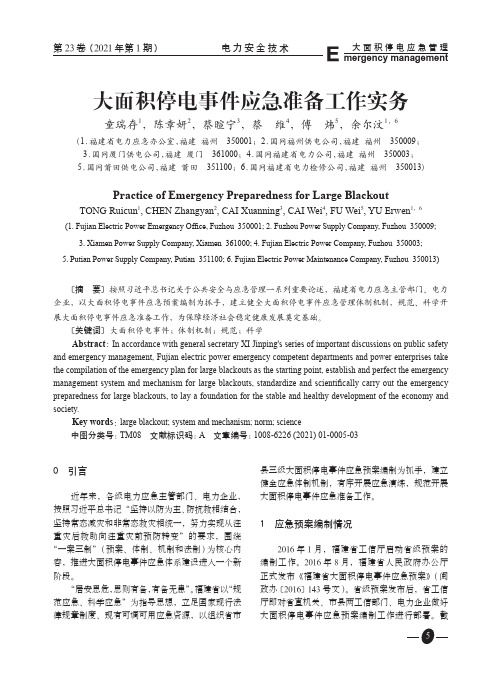
大面积停电事件应急准备工作实务童瑞存1,陈章妍2,蔡暄宁3,蔡 维4,傅 炜5,余尔汶1,6(1.福建省电力应急办公室,福建 福州 350001;2.国网福州供电公司,福建 福州 350009;3.国网厦门供电公司,福建 厦门 361000;4.国网福建省电力公司,福建 福州 350003;5.国网莆田供电公司,福建 莆田 351100;6.国网福建省电力检修公司,福建 福州 350013)Practice of Emergency Preparedness for Large Blackout TONG Ruicun1, CHEN Zhangyan2, CAI Xuanning3, CAI Wei4, FU Wei5, YU Erwen1,6(1. Fujian Electric Power Emergency Office, Fuzhou 350001; 2. Fuzhou Power Supply Company, Fuzhou 350009;3. Xiamen Power Supply Company, Xiamen 361000;4. Fujian Electric Power Company, Fuzhou 350003;5. Putian Power Supply Company, Putian 351100;6. Fujian Electric Power Maintenance Company, Fuzhou 350013)〔摘 要〕 按照习近平总书记关于公共安全与应急管理一系列重要论述,福建省电力应急主管部门、电力企业,以大面积停电事件应急预案编制为抓手,建立健全大面积停电事件应急管理体制机制,规范、科学开展大面积停电事件应急准备工作,为保障经济社会稳定健康发展奠定基础。
〔关键词〕 大面积停电事件;体制机制;规范;科学Abstract: In accordance with general secretary XI Jinping's series of important discussions on public safety and emergency management, Fujian electric power emergency competent departments and power enterprises take the compilation of the emergency plan for large blackouts as the starting point, establish and perfect the emergency management system and mechanism for large blackouts, standardize and scientifically carry out the emergency preparedness for large blackouts, to lay a foundation for the stable and healthy development of the economy and society.Key words: large blackout; system and mechanism; norm; science中图分类号:TM08 文献标识码:A 文章编号:1008-6226 (2021) 01-0005-030 引言近年来,各级电力应急主管部门、电力企业,按照习近平总书记“坚持以防为主、防抗救相结合,坚持常态减灾和非常态救灾相统一,努力实现从注重灾后救助向注重灾前预防转变”的要求,围绕“一案三制”(预案、体制、机制和法制)为核心内容,推进大面积停电事件应急体系建设进入一个新阶段。
美加“”大停电介绍以及启示共50页

21、没有人陪你走一辈子,所以你要 适应孤 独,没 有人会 帮你一 辈子, 所以你 要奋斗 一生。 22、当眼泪流尽的时候,留下的应该 是坚强 。 23、要改变命运,首先改变自己。
24、勇气很有理由被当作人类德性之 首,因 为这种 德性保 证了所 有其余 的德性 。--温 斯顿. 丘吉尔 。 25、梯子的梯阶从来不是用来搁脚的 ,它只 是让人 们的脚 放上一 段时间 ,以便 让别一 只脚能 够再往 上登。
21、要知道对好事的称颂过于夸大,也会招来人们的反感轻蔑和嫉妒。——培根 22、业精于勤,荒于嬉;行成于思,毁于随。——韩愈
23、一切节省,归根到底都归结为时间的节省。——马克思 24、意志命运往往背道而驰,决心到最后会全部推倒。——莎士比亚
25、学习是劳动,是充满思想的劳动。——乌申斯基
谢谢!
美国经济大萧条 (全英文).ppt
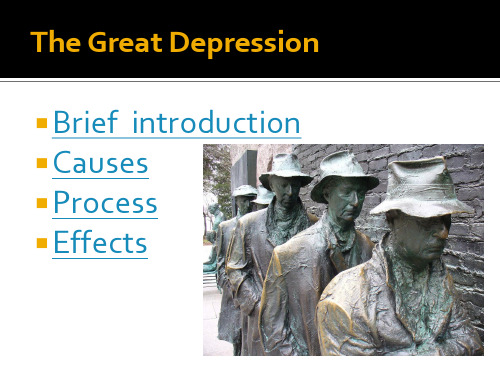
Start of the Great Depression 1
The depression originated in the U.S., starting with the fall in stock prices that began around September 4, 1929 and became worldwide news with the stock market crash of October 29, 1929 (known as Black Tuesday). From there, it quickly spread to almost every country in the world.
Black Tuesday
Causes
Demand-driven Keynesian Breakdown of international trade Debt deflation Monetarist New classical approach Austrian School Inequality Productivity shock
Austrian School
Theorists of the "Austrian School" who wrote about the Depression include Austrian economist Friedrich Hayek and American economist Murray Rothbard, who wrote America's Great Depression (1963). In their view and like the monetarists, the Federal Reserve, which was created in 1913, shoulders much of the blame; but in opposition to the monetarists, they argue that the key cause of the Depression was the expansion of the money supply in the 1920s that led to an unsustainable credit-driven boom.
第4课 经济大危机A

罗斯福发表“炉边谈话”
为了恢复公众对银行的信任,1933年3月12日,罗斯福通过无线电广 播发表“炉边谈话”,向公众解释关闭银行的原因及联邦政府重整金融系 统的措施,同时宣布将陆续使经过合格的银行重新开业。
第4课 经济大危机
罗斯福与美国农民进行交谈
第4课 经济大危机
罗斯福的若干政策
农业方面 :《农业调整法》 工业方面:《全国工业复兴法》 《全国劳资关系法》 其他措施:《民用工程紧急救济法》 《紧急救济拨款法》 《社会保障法》„„
第4课 经济大危机
600 500 400 300 200 100 0 50 40 30 20 10 0 -10 -20 1933年 1935年
单位:亿美元 单位:亿美元
美国国民总收入增长示意图
1933年 1935年
美国公司利润增长示意图
第4课 经济大危机
美国公民领取的失业保险卡
返 回
第4课 经济大危机
第4课 经济大危机
■“繁荣”及其崩溃
■罗斯福新政
第4课 经济大危机
导入
1929年10月,华尔街金融大崩溃。图中的牌子上写道:“100美 元可买下这辆车,在股市上丧失了一切,急需现钞。”
第4课 经济大危机
“繁荣”及其崩溃
第4课 经济大危机
黑色星期四的华尔街
焦虑不安的人们注视着华尔街股票的下跌
1929年10月24日,美国纽约证券交易所股票崩溃,这一天被称为“黑色星期四”。
第4课 经济大危机
大规模兴建公共工程,使失业者重新获得工作。
第4课 经济大危机
“新政”实施前,只有10%的乡村能用上电。到1941年,由于 政府的低息贷款的投入,已有40%乡村用上了电力。
第4课 经济大危机
新概念青少版入门A教案
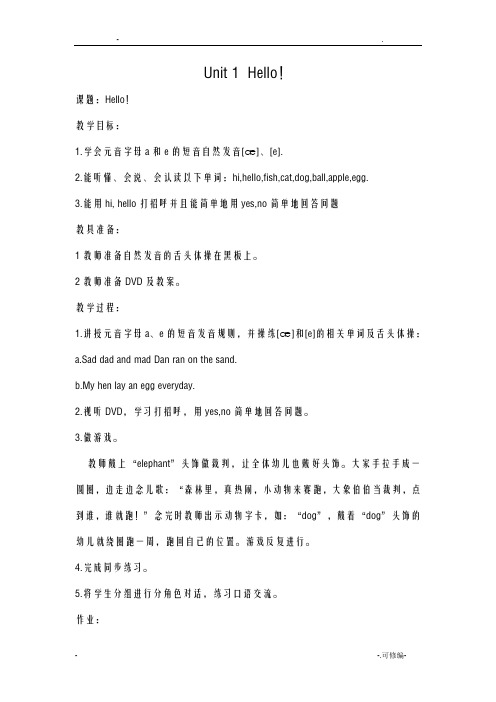
Unit1Hello!课题:Hello!教学目标:1.学会元音字母a和e的短音自然发音[æ]、[e].2.能听懂、会说、会认读以下单词:hi,hello,fish,cat,dog,ball,apple,egg.3.能用hi,hello打招呼并且能简单地用yes,no简单地回答问题教具准备:1教师准备自然发音的舌头体操在黑板上。
2教师准备DVD及教案。
教学过程:1.讲授元音字母a、e的短音发音规则,并操练[æ]和[e]的相关单词及舌头体操:a.Sad dad and mad Dan ran on the sand.b.My hen lay an egg everyday.2.视听DVD,学习打招呼,用yes,no简单地回答问题。
3.做游戏。
教师戴上“elephant”头饰做裁判,让全体幼儿也戴好头饰。
大家手拉手成一圆圈,边走边念儿歌:“森林里,真热闹,小动物来赛跑,大象伯伯当裁判,点到谁,谁就跑!”念完时教师出示动物字卡,如:“dog”,戴着“dog”头饰的幼儿就绕圈跑一周,跑回自己的位置。
游戏反复进行。
4.完成同步练习。
5.将学生分组进行分角色对话,练习口语交流。
作业:1.大声朗读自然发音、生词并记忆。
2.练习打招呼的对话以及用本单元学过的单词与句型与搭档互换角色相互问答。
教学反思:一二年级的孩子已经具有了一定的词汇量和口语表达量,但是要开始注重规书写了。
Unit2Yummy!课题:Yummy!教学目标:1.学会元音字母i、o、u的短音自然发音[i]、[ɔ]、[u].2.2.了解一些口语俚语yummy,yuk,help,stop.3.掌握重点词汇:girl,hat,insect,jelly,kite,green,red.教具准备:1教师准备自然发音的舌头体操在黑板上。
2教师准备教学果冻、卡片、DVD及教案。
教学过程:1.讲授元音字母i、o、u的短音发音规则,操练[i]、[ɔ]、[u]的相关单词及舌头操:2.a.A big ship is sailing on the sea.b.Clock on the top of the box.c.The bug jumped up onto the bus.2.发给每位小朋友一个果冻,教其说"Yummy!"。
